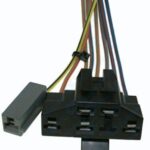Obd2 Bidirectional scanners are revolutionizing how mechanics diagnose and troubleshoot car problems. Unlike traditional OBD2 scanners that only read diagnostic trouble codes (DTCs), bidirectional scanners can also send commands to various vehicle systems. This article delves into the capabilities of these powerful tools, addressing common questions and highlighting their benefits.
Understanding OBD2 Bidirectional Functionality
OBD2 bidirectional control allows mechanics to actively test components and systems. This functionality goes beyond simply reading codes; it enables users to perform actions like:
- Activating solenoids and relays: Test fuel injectors, cooling fans, and other actuators.
- Controlling lights and other outputs: Verify proper functioning of headlights, taillights, and interior lights.
- Performing bi-directional tests: Conduct specific tests on components like ABS modules or EVAP systems. This allows for a more thorough diagnosis compared to traditional code readers.
- Simulating driving conditions: By activating certain components, mechanics can simulate specific driving scenarios to pinpoint issues that might not show up during a normal test drive.
Common Questions About OBD2 Bidirectional Scanners
Do all OBD2 scanners have bidirectional capabilities?
No, not all OBD2 scanners offer bidirectional functionality. This feature is typically found in professional-grade diagnostic tools. Standard OBD2 code readers primarily focus on retrieving DTCs and providing basic vehicle information.
Will an OBD2 bidirectional scanner work on my car?
While most OBD2 compliant vehicles (1996 and newer in the US) can be scanned for basic information, the extent of bidirectional control varies depending on the vehicle’s make, model, and year. Some functionalities may be limited or unavailable on certain vehicles.
Can a bidirectional scanner reprogram vehicle computers?
Generally, no. OBD2 bidirectional scanners are primarily diagnostic tools, not programming tools. Reprogramming vehicle computers typically requires specialized software and equipment. Key fob programming is also not typically supported.
What if my car won’t start? Can I still use a bidirectional scanner?
No, the vehicle needs to be at least in a crank condition for the OBD2 scanner to communicate with the vehicle’s electronic control units (ECUs). If the vehicle cannot start or crank, the scanner won’t be able to establish a connection.
Troubleshooting Connection Issues
If your OBD2 bidirectional scanner isn’t working, try these steps:
- Check the connection: Ensure the scanner is properly connected to the vehicle’s OBD2 port.
- Power cycle the scanner: Turn the scanner off and on again.
- Inspect the OBD2 port: Check for any damage or debris in the vehicle’s OBD2 port. Clean the connections if necessary.
Conclusion
OBD2 bidirectional scanners offer advanced diagnostic capabilities that empower mechanics to identify and resolve car problems more efficiently. By enabling active testing and component control, these tools provide a deeper understanding of vehicle systems. However, it’s crucial to understand that bidirectional functionality is not universal and may vary depending on the specific vehicle and scanner model. Choosing the right scanner with the necessary capabilities for your diagnostic needs is essential.

